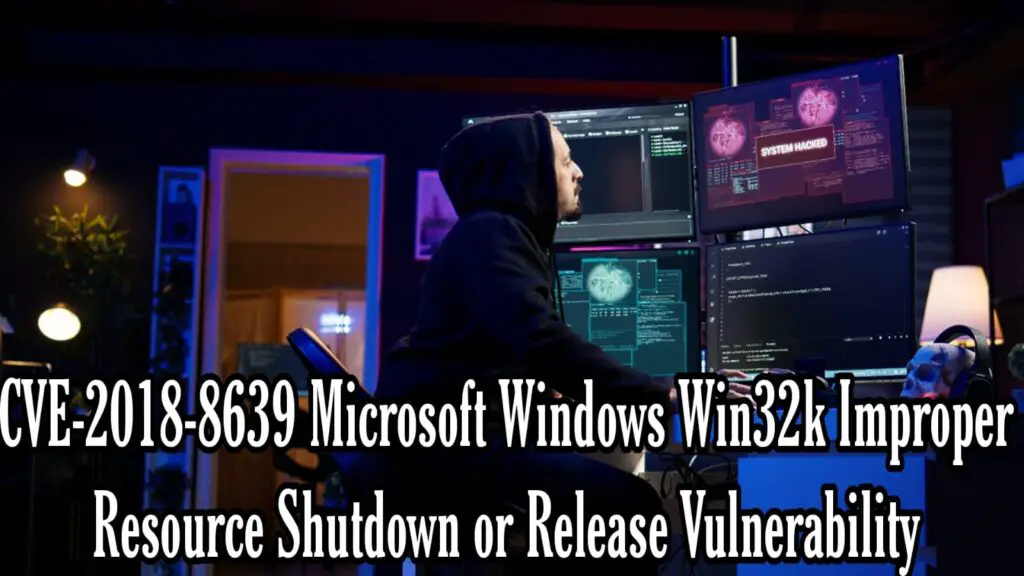[Solved] CVE-2018-8639 Microsoft Windows Win32k Improper Resource Shutdown or Release Vulnerability

Introduction: The Hidden Danger Lurking in Your Windows System
If you’re still ignoring security patches, it’s time to wake up! CVE-2018-8639 is a ticking time bomb in Windows, an elevation of privilege vulnerability that gives hackers the power to hijack your system. This flaw resides in Win32k.sys, a critical Windows kernel component, and if exploited, it grants attackers complete control over your machine. Think you’re safe? Think again—if your system is unpatched, you’re basically handing over admin access to cybercriminals on a silver platter.
What Makes CVE-2018-8639 So Dangerous?
Unlike flashy remote exploits that require user interaction, CVE-2018-8639 is stealthy and devastating. It doesn’t need social engineering, phishing, or any user intervention. A hacker who already has a foothold in your system (even with limited access) can leverage this vulnerability to escalate privileges and take over your system entirely.
Here’s why this exploit is a serious threat:
- Kernel-Level Access: Hackers gain full system control, making it nearly impossible to detect or stop their actions.
- No User Interaction Required: The attack doesn’t rely on fooling users; it simply exploits a weakness in Windows.
- Wide Attack Surface: It affects multiple versions of Windows, from Windows 7 to Windows 10 and even Windows Server versions.
Technical Breakdown: How the Exploit Works
CVE-2018-8639 is caused by improper resource management in the Win32k component. Specifically, Windows fails to correctly handle objects in memory, allowing an attacker to exploit this flaw and escalate their privileges.
Attack Flow:
- The attacker first gains low-level access to a system, usually via malware, unpatched vulnerabilities, or compromised credentials.
- Using CVE-2018-8639, they manipulate system memory to elevate their privileges.
- Once they have kernel-level access, they can disable security measures, install malware, steal sensitive data, and even create hidden backdoors.
- Your system is now fully compromised—without you even noticing.
This vulnerability is classified under CWE-404: Improper Resource Shutdown or Release, meaning Windows fails to release system resources properly, leading to dangerous memory corruption and privilege escalation.
Who Is Affected? (Hint: Probably YOU)
If you’re running any of these Windows versions and haven’t patched yet, you’re vulnerable:
- Windows 7 SP1
- Windows 8.1, Windows RT 8.1
- Windows 10 (versions 1607, 1703, 1709, 1803, 1809)
- Windows Server 2008 SP2, 2008 R2, 2012, 2012 R2, 2016, 2019
That’s a massive list—meaning a vast number of machines out there are still exposed!
Severity Score: High Risk, High Damage
Microsoft and security researchers have classified CVE-2018-8639 as high severity (CVSS score: 7.8). Let’s break down why:
- Attack Vector: Local (an attacker must already have some system access)
- Attack Complexity: Low (easy to exploit)
- Privileges Required: Low (even a basic user can execute it)
- User Interaction: None (it works without any user action)
- Impact: High (complete system compromise)
The Real-World Impact
Once exploited, an attacker can:
- Gain full admin access
- Disable antivirus & security defenses
- Steal sensitive data
- Deploy ransomware or spyware
- Use your system for further attacks
How to Protect Yourself – Patch or Perish!
There is only one way to defend against this vulnerability: PATCH IMMEDIATELY! Microsoft released a security update in December 2018, but if you haven’t applied it, you’re still at risk.
Step-by-Step Protection Guide:
- Update Your System – Install the latest security updates from Microsoft.
- Enable Automatic Updates – Don’t rely on manual patching, set updates to automatic.
- Monitor Privilege Escalation – Use security tools to detect unusual privilege changes.
- Limit User Privileges – Reduce admin access to only those who truly need it.
- Implement Application Whitelisting – Prevent unauthorized execution of malicious files.
- Regularly Audit Security Logs – Keep track of unexpected changes in user roles and permissions.
- Use Endpoint Protection Solutions – Deploy security tools that can detect privilege escalation attempts.
- Train Employees on Security Awareness – Teach your team about the dangers of unpatched vulnerabilities and privilege escalation.
The Bigger Picture: Why Attackers Love Privilege Escalation Exploits
CVE-2018-8639 is a textbook example of why privilege escalation vulnerabilities are so valuable to hackers. Attackers often use these exploits as part of a larger campaign:
- Initial Infection: Through phishing, drive-by downloads, or exploiting another vulnerability.
- Privilege Escalation (CVE-2018-8639): Gain admin access and disable security protections.
- Lateral Movement: Spread across the network, infecting other machines.
- Exfiltration and Persistence: Steal data, deploy ransomware, and ensure long-term access.
Cybercriminals don’t just exploit a single vulnerability; they chain multiple exploits together to maximize damage. This is why patching every known vulnerability is critical—one weak spot is all an attacker needs.
Conclusion: Take Action Before It’s Too Late
CVE-2018-8639 is not just another vulnerability—it’s a major security flaw that can turn any compromised system into a hacker’s playground. If you haven’t patched it yet, you are playing with fire. Apply the fix NOW, before attackers exploit your system and make you regret your inaction.
The cybersecurity landscape is brutal. Hackers are constantly on the lookout for unpatched systems, and privilege escalation flaws like CVE-2018-8639 are their golden ticket to full system compromise.
Don’t be the next victim. Patch your Windows system today!
Related posts:
- How to Download offline setup of Microsoft Store App
- Mitigate WinVerifyTrust Signature Validation Vulnerability CVE-2013-3900
- Microsoft Streaming Service Elevation of Privilege Vulnerability (CVE-2023-29360)
- Microsoft MSHTML Remote Code Execution Vulnerability
- [Solved] How to solve Windows update error 0x800f0831- CBS E_STORE_CORRUPTION
- How to Use GenAI Prompting for Security Vulnerabilities
- BeyondTrust Privileged Remote Access and Remote Support products Vulnerability (CVE-2024-12356 & CVE-2024-12686
- [Solved] Critical UEFI Secure Boot Vulnerability (CVE-2024-7344)
- March 2025 Patch Tuesday: A Stabilizing Security Landscape
- CVE-2025-24991: Unmasking the Windows NTFS Out-Of-Bounds Read Vulnerability

купить аккаунт https://kupit-akkaunt.online/
buy tiktok ads buy tiktok ads account
tiktok ads account for sale https://tiktok-agency-account-for-sale.org
buy tiktok ads accounts https://buy-tiktok-ad-account.org
buy tiktok ads accounts https://buy-tiktok-ads-accounts.org